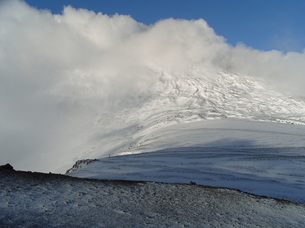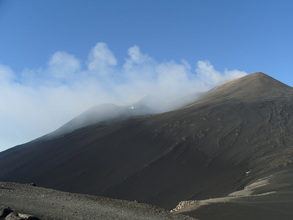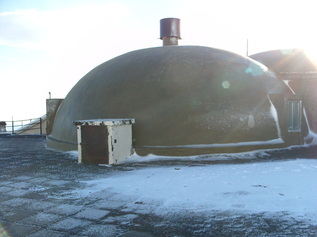 I meant to post this way back in September after my latest field visit to Mount Etna, but never got round to it/forgot! A couple of photos showing how quickly the weather can change on Etna. The day before it was very cold but no signs of snow and woke up to this the next morning. Below is the Pizzi Deneri volcano observatory where I was lucky enough to stay for a week during September. Needless to say not a lot of work got done on this day and a hasty retreat back down the flanks was made (to where it was nice and warm!). This serves to demonstrate that there are more hazards when working on a volcano than just the volcano itself!  The plume at Mt Etna. First of all, happy new year! It is set to be a busy one for myself, no doubt involving various volcanic visits which you will all here about. Today, in my why is gas important series, a brief look at 'Passive Degassing'. This is gas which is released at all times from a volcano, even when there is no eruption occuring. This can also be termed as quiescent. The major gases emitted include Water Vapour, Carbon Dioxide and Sulphur Dioxide (amongst others) and are usually in that order for amounts released. Monitoring emissions of gas is important as it can inform volcanologists of amounts that are being released and whether these are in a normal range. An increase in emissions could indicate that an eruption is imminent, but a decrease could also indicate the same! It can vary greatly on a volcano basis. For example, an increase in emissions could indicate that a fresh batch of magma has entered the plumbing system with lots of entrained gas (the major driver of volcanic eruptions) and the increased emissions at the surface is showing this. Or there could be a large decrease in emissions, which could indicate that either there is a shortfall in gas supply from depth or that the gas cannot escape. This could indicate a build up in pressure and that a volcanic eruption is more likely. Of course, to make such assessments accurately a detailed history of amounts of gas released is needed to determine the normal behaviour for a given volcano. As with all volcanic situations, a large and unusual change in emissions doesn't necessarily mean an eruption will occur! How do we measure these emissions? There are a variety of technqiues, those which involve collecting gas from fumaroles or a plume or remote sensing techniques be it via a satellite or more mobile ground-based cameras. Most monitoring is of Sulphur Dioxide due to its ease of measurement. Of course emission of other gases are also important. The eruption of Laki, Iceland released a large amount of Fluorine which is thought to have caused a large amount of disease throughout Europe. |
Archives
July 2023
|


 RSS Feed
RSS Feed